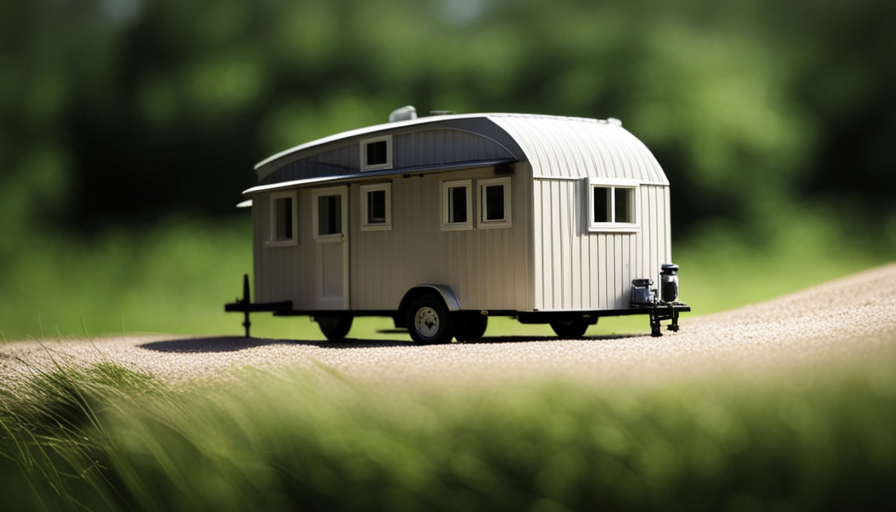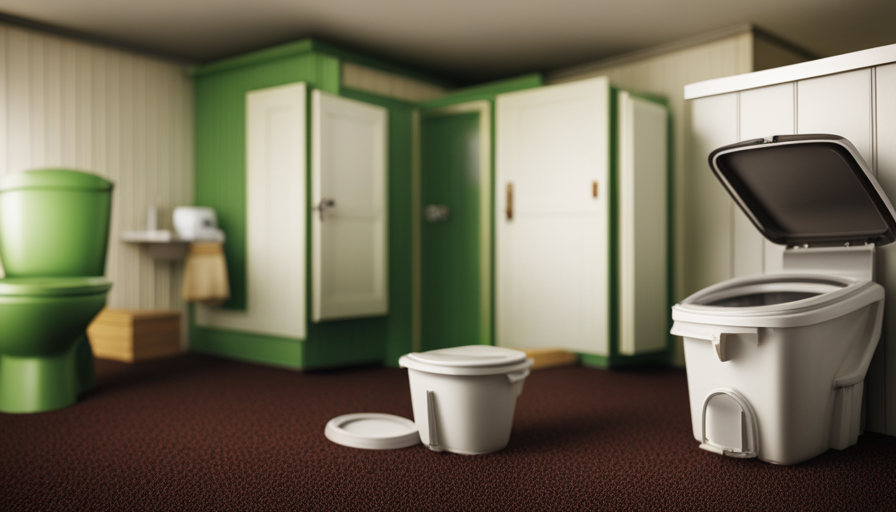Allow me to start with a reality check: small homes are actually portable. Many people think that these cozy dwellings are permanent fixtures, but that couldn’t be further from the truth. As a passionate advocate of the tiny house movement, I have delved deep into this topic to offer you a comprehensive guide on the mobility of these unique homes.
In this article, we will explore the basics of tiny house mobility, from choosing the right foundation to legal considerations and planning the logistics of a move. We will also discuss the practicalities of dealing with utilities and infrastructure, budgeting for moving expenses, and the importance of insurance and liability. Whether you’re considering long-term mobility or temporary relocation, this article aims to provide you with the knowledge and resources needed to make your tiny house dreams a reality on the move.
Key Takeaways
- Tiny houses can be moved despite common misconception
- Choosing the right materials and understanding weight distribution is important for safe transportation
- Two main options for foundations: trailers or skids/wheels, with trailers generally preferred for flexibility in moving
- Hiring professional movers provides expertise, equipment, and can navigate urban challenges
Understanding the Basics of Tiny House Mobility
So, can you just hitch up your tiny house and take it on a cross-country adventure whenever you feel like it? Well, it’s not that simple. When it comes to moving a tiny house, there are several factors to consider.
One of the most important considerations is choosing the right materials to ensure the structural integrity of your home during transportation. Lightweight yet durable materials, such as steel framing and lightweight insulation, are often preferred.
Another key factor is understanding weight distribution. Properly distributing the weight inside the house is crucial for safe and smooth transportation. This includes evenly distributing heavy appliances and furniture.
By choosing the right materials and understanding weight distribution, you can ensure that your tiny house is ready for the road.
Now, let’s delve into the next section about choosing the right foundation for mobility.
Choosing the Right Foundation for Mobility
When it comes to choosing the right foundation for a mobile tiny house, there are two main options to consider: a trailer or skids/wheels.
Each has its own pros and cons, and it’s important to carefully weigh them before making a decision.
Additionally, ensuring the structural integrity of the tiny house for transportation is crucial to avoid any damage or accidents during the moving process.
As someone who’s passionate about tiny house living, I know that making the right foundation choice and ensuring structural integrity are vital steps in creating a mobile tiny house that can be safely transported to different locations.
Trailer vs. Skids or Wheels
If you’re considering a tiny house, you’ll be glad to know that opting for a trailer will allow you to easily transport your home to different locations, like hitching up a cozy cabin on wheels and embarking on endless adventures.
When it comes to choosing the right foundation for mobility, there are two main options to consider: a trailer or skids/wheels. While both have their advantages, trailers are generally the preferred choice for those who want the flexibility to move their tiny house whenever they please. Trailers require regular maintenance, such as checking the tires and brakes, but they offer the convenience of being able to hook up to a vehicle and hit the road.
Ensuring structural integrity for transportation is crucial, as the tiny house will experience movement and vibrations during travel.
Moving on to the next section, let’s dive into how to ensure the stability of your tiny house during transportation.
Ensuring Structural Integrity for Transportation
To ensure your mobile home stays safe and secure during travel, it’s essential to prioritize the structural integrity of your chosen foundation. This means choosing the proper permits and ensuring that your tiny house is built to withstand transportation. Whether you opt for a trailer, skids, or wheels, it’s crucial to reinforce the structure to withstand the stresses of the road. One way to ensure structural integrity is by using high-quality materials and construction techniques that can withstand movement. Additionally, securing your belongings during transportation is vital to prevent damage. Consider using straps, bungee cords, or other restraints to secure furniture and other items inside your tiny house. By taking these precautions, you can have peace of mind knowing that your tiny house will arrive at its destination safely. Moving on to legal and regulatory considerations, it’s important to…
Legal and Regulatory Considerations
Legal and regulatory limitations may limit the mobility of tiny houses. When considering moving a tiny house, it’s important to understand the legal restrictions that may be in place. Navigating zoning laws is crucial to ensure compliance and avoid any potential legal issues.
Some areas have specific regulations regarding the size, type, and location of dwellings, which can affect the mobility of tiny houses. Additionally, certain municipalities may require permits or inspections before allowing the transportation of a tiny house. It’s essential to research and comply with these regulations to ensure a smooth and hassle-free move.
Planning the route and logistics of moving a tiny house is the next crucial step. By carefully considering the size and weight of the tiny house, along with any height restrictions or road limitations, a successful move can be achieved.
Planning the Route and Logistics
When planning the route and logistics for moving a tiny house, there are two key points to consider.
First, it’s important to assess road accessibility and weight restrictions in order to ensure a smooth and legal transportation process. This involves researching the specific roads and highways that will be used, as well as any potential obstacles or limitations along the way.
Additionally, a decision must be made between hiring professional movers or DIY transportation. While hiring professionals can provide expertise and convenience, opting for a DIY approach allows for more flexibility and cost savings.
Ultimately, careful consideration of these factors will help ensure a successful and stress-free move.
Assessing Road Accessibility and Weight Restrictions
Assessing road accessibility and weight restrictions can determine whether tiny houses can be easily moved to different locations. It’s crucial to consider road conditions and weight limits to ensure a smooth and successful transportation process. Road conditions play a significant role in determining whether the tiny house can be moved safely. Narrow or unpaved roads might pose challenges and increase the risk of damage to the house during transportation.
Additionally, weight limits imposed by different jurisdictions must be taken into account. Exceeding these limits can result in fines or even legal issues. It’s important to carefully assess road accessibility and weight restrictions before attempting to move a tiny house. By doing so, you can avoid potential roadblocks and ensure a hassle-free relocation.
Transitioning into the subsequent section about hiring professional movers or DIY transportation, it’s essential to consider these factors when deciding the best method of moving a tiny house.
Hiring Professional Movers or DIY Transportation
Consider the benefits of hiring professional movers to ensure a smooth and stress-free transportation process, as the saying goes, ‘Many hands make light work.’
Here are three reasons why hiring professionals can make a big difference when moving a tiny house:
- Expertise: Professional movers have the knowledge and experience to handle the unique challenges of moving a tiny house, such as securing it properly, navigating tight spaces, and complying with weight restrictions on the road.
- Equipment: Moving a tiny house requires specialized equipment like trailers, cranes, and dollies. Hiring professional movers means you don’t have to worry about renting or purchasing this equipment yourself.
- Urban Challenges: Moving a tiny house in urban areas can be particularly challenging due to narrow streets, parking restrictions, and potential damage to surrounding properties. Professional movers are familiar with these obstacles and can navigate them more effectively.
By entrusting the transportation of your tiny house to professionals, you can focus on other aspects of the move, such as dealing with utilities and infrastructure without the added stress of physically moving the house yourself.
Dealing with Utilities and Infrastructure
To make your tiny house even more mobile, you can easily connect it to various utilities and infrastructure. Dealing with off-grid options is essential for those who want to minimize their environmental impact.
There are several ways to achieve this. One option is to install solar panels on the roof of your tiny house, which can provide you with renewable energy and reduce your reliance on the grid. Another option is to collect rainwater and use it for your daily needs, such as flushing the toilet or watering plants. Additionally, composting toilets can be a great solution for those who want to avoid using traditional plumbing.
These off-grid options not only make your tiny house more sustainable but also allow you to live independently and free from the constraints of traditional utilities. Ensuring safety and stability during transportation is crucial, as any movement can potentially damage your tiny house.
Ensuring Safety and Stability during Transportation
Ensuring a smooth journey for your mobile abode is like taming a wild stallion – you need to secure it tightly, reinforce its structure, and prepare for any bumps in the road. Here are five key steps to ensure the safety and stability of your tiny house during transportation:
- Choosing the right towing vehicle: Select a vehicle with adequate towing capacity and ensure it’s properly equipped for the job.
- Securing the tiny house for transportation: Use heavy-duty straps, chains, and braces to secure the house to the trailer, making sure it’s tightly fastened from all angles.
- Reinforcing the structure: Strengthen vulnerable areas such as windows, doors, and roof to withstand the stresses of transportation.
- Inspecting the tires and brakes: Ensure the tires are properly inflated and in good condition, and check the brakes for optimal functionality.
- Testing the setup: Take the tiny house on a short test drive to ensure everything’s secure and stable before embarking on a long journey.
By following these steps, you can have peace of mind knowing that your tiny house is safe and secure during transportation.
Now, let’s transition to the next section about budgeting for moving expenses.
Budgeting for Moving Expenses
When it comes to budgeting for moving expenses, there are a few key points to consider.
Firstly, transportation costs can vary depending on the distance and method of transportation. It’s important to factor in the cost of hiring a professional moving company or renting a truck if you plan on moving the tiny house yourself.
Additionally, there may be additional expenses for setting up the tiny house at its new location, such as permits, foundation preparation, and utility connections.
By carefully considering these costs, you can ensure that you’re prepared financially for the process of moving your tiny house.
Transportation Costs
Transportation costs for moving tiny houses can vary depending on the distance and method of transportation. It is important to consider transportation regulations and cost-saving tips when planning the move. Here is a breakdown of potential transportation costs:
| Method of Transportation | Distance | Estimated Cost |
|---|---|---|
| Flatbed Trailer | Short | $500-$1,000 |
| Towing Service | Medium | $1,000-$2,500 |
| Professional Movers | Long | $2,500-$5,000 |
These estimates are just rough guidelines and actual costs may vary. To save on transportation expenses, you can consider renting a trailer or hiring a towing service instead of professional movers for shorter distances. Additionally, being aware of transportation regulations, such as obtaining the necessary permits, can help avoid any legal issues or fines. Once the transportation costs are accounted for, it is important to consider additional expenses for setup and utilities.
Additional Expenses for Setup and Utilities
To fully settle into your new cozy abode, there are some important costs to consider beyond just getting it to its destination. Additional costs involved in the setup and utilities of a tiny house can vary depending on the specific needs and preferences of the homeowner.
One of the major expenses is the foundation or support system for the tiny house, which may require professional installation. Additionally, connecting the house to utilities such as water, electricity, and sewage can incur additional expenses. This may involve hiring contractors or obtaining permits, which adds to the planning process.
It’s crucial to thoroughly research and budget for these costs beforehand to avoid any surprises.
Now, let’s delve into the next section about insurance and liability considerations.
Insurance and Liability Considerations
Insurance coverage and liability can be tricky when it comes to tiny houses and their mobility. Since tiny houses are considered unique and unconventional, it can be challenging to find insurance policies that specifically cater to them. Traditional homeowners’ insurance may not provide adequate coverage for the unique risks associated with tiny houses.
It is essential to find an insurance provider that understands the specific needs and risks of tiny house owners. Liability risks should also be carefully considered, as accidents or damage that occur during the transportation of a tiny house can lead to legal issues. Therefore, it’s crucial to have proper liability coverage in place to protect oneself from potential lawsuits.
As we move forward into discussing long-term mobility vs. temporary relocation, it’s important to understand the insurance and liability considerations involved in both scenarios.
Long-Term Mobility vs. Temporary Relocation
Now that we’ve examined the insurance and liability considerations of moving a tiny house, let’s delve into the challenges of long-term mobility and the considerations for temporary relocation.
When it comes to long-term mobility, there are several factors to consider. First and foremost, you need to assess whether your tiny house is built to withstand frequent transportation. The structural integrity of the house should be carefully evaluated to ensure it can withstand the stress of being moved regularly. Additionally, you may need to obtain permits or comply with regulations when moving your tiny house to different locations.
On the other hand, if you’re considering temporary relocation, you should think about the practicality and cost of moving your tiny house for short periods of time. It may be more feasible to find alternative accommodation during these temporary stays.
As we move forward, let’s explore the resources and support available for tiny house mobility without compromising its integrity.
Resources and Support for Tiny House Mobility
When it comes to the mobility of tiny houses, online communities and forums can be a valuable resource for information and support. These platforms provide a space for tiny house enthusiasts to connect, share experiences, and exchange tips on moving their homes.
Additionally, professional services and consultations can offer expert guidance on the logistics and legalities of relocating a tiny house, ensuring a smooth and successful transition.
Online Communities and Forums
With online communities and forums, there’s a whole world of tiny house enthusiasts waiting to share their experiences and offer support. These online resources provide a wealth of knowledge and information, making it easier for individuals interested in tiny house mobility to navigate the process.
Here are four key benefits of engaging with these communities:
- Advice and Tips: Online forums allow you to interact with experienced tiny house owners who can provide valuable advice on everything from choosing the right trailer to securing your tiny house for transportation.
- Design Inspiration: Browse through countless photos and stories shared by community members to find inspiration for your own tiny house design. From clever storage solutions to innovative space-saving ideas, these communities offer a treasure trove of inspiration.
- Troubleshooting: If you encounter any challenges during your tiny house moving journey, these communities can offer solutions and troubleshooting tips based on their own experiences.
- Emotional Support: Building and moving a tiny house can be a daunting task. Online communities provide a supportive environment where you can connect with like-minded individuals who understand the unique challenges and joys of tiny house living.
By engaging with these online communities and forums, you can gain valuable insights and support as you embark on your tiny house mobility journey. In the next section, we’ll explore the benefits of professional services and consultations in further detail.
Professional Services and Consultations
Engaging with professional services and consultations can greatly enhance my understanding and expertise in the process of relocating my small home. By seeking professional advice, I can gain valuable insights into the logistics and requirements of moving a tiny house. These experts can provide guidance on the best practices for securing and transporting my home safely and efficiently.
Additionally, they can offer recommendations for reliable relocation services that specialize in moving tiny houses. Their expertise can help me navigate any legal or permit requirements associated with moving my small home to a new location. With their assistance, I can ensure a smooth and successful relocation, minimizing any potential challenges or risks.
Trusting professionals in this field will ultimately save me time, effort, and potential headaches in the long run.
Frequently Asked Questions
Can I move my tiny house by myself or do I need professional help?
Moving a tiny house by myself was a daunting task. I underestimated the weight and complexity involved. Struggling to maneuver it, I realized I needed professional help.
Hiring experienced movers for my tiny house was a game-changer. They had the expertise, equipment, and manpower to handle the job efficiently and safely. From navigating narrow streets to securing the house during transport, they took care of everything.
Trust me, it’s worth investing in professionals for a smooth and stress-free move.
What are the common challenges faced when moving a tiny house long distances?
When moving a tiny house long distances, there are several common challenges to consider.
One of the main obstacles is weight restrictions. Tiny houses are designed to be lightweight, but they can still exceed weight limits on certain roads or bridges. This means you may need to plan alternative routes or remove some items to meet the requirements.
Additionally, navigating narrow roads or tight corners can be tricky, requiring careful maneuvering and potentially professional assistance.
Are there any weight restrictions for towing a tiny house on the road?
Yes, there are weight restrictions when it comes to towing a tiny house on the road. These restrictions vary depending on the state and country you’re in. It’s crucial to check the specific towing requirements and regulations for your area before attempting to move your tiny house. Exceeding weight restrictions can lead to fines, safety hazards, and potential damage to your tiny house. It’s important to prioritize safety and adhere to these guidelines to ensure a smooth and successful move.
How do I secure my belongings inside the tiny house during transportation?
Securing my belongings inside a tiny house during transportation is crucial. Fragile items should be carefully packed and padded to prevent damage. I recommend using bubble wrap or packing peanuts for extra protection.
To organize furniture, I suggest securing it to the walls or floor with straps or bungee cords. This will prevent shifting and potential damage.
Remember, taking the time to properly secure your belongings ensures a smooth and worry-free journey for your tiny house.
Are there any special permits or licenses required to move a tiny house?
To move a tiny house, special permits and licenses may be required depending on your location and the size of the house. It’s important to research and comply with local regulations to ensure a smooth and legal move.
These permits and licenses typically address transportation and safety concerns. They may include requirements for road and route planning, vehicle specifications, and even insurance coverage.
Always consult local authorities and professionals to make sure you have all the necessary documentation in place.
Conclusion
In conclusion, the mobility of tiny houses is a reality for those who desire a nomadic lifestyle or temporary relocation. By choosing the right foundation and considering legal and regulatory factors, planning the route and logistics, and dealing with utilities and infrastructure, tiny house owners can successfully move their homes.
Budgeting for moving expenses, ensuring proper insurance coverage, and seeking resources and support can further ease the process. While some may question the practicality of moving a tiny house, the visual representation of a cozy, mobile home nestled amidst breathtaking landscapes will undoubtedly ignite a sense of wanderlust and inspire others to embrace the freedom and flexibility that tiny house mobility offers.
I’m Theodore, and I love tiny houses. In fact, I’m the author of Tiny House 43, a book about tiny houses that are also tree houses. I think they’re magical places where imaginations can run wild and adventures are just waiting to happen.
While tree houses are often associated with childhood, they can be the perfect adult retreat. They offer a cozy space to relax and unwind, surrounded by nature. And since they’re typically built on stilts or raised platforms, they offer stunning views that traditional homes simply can’t match.
If you’re looking for a unique and romantic getaway, a tree house tiny house might just be the perfect option.










